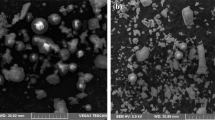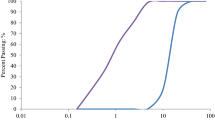Abstract
The settlement of high embankments constructed over soft compressible soil deposits is affected by the self-weight of the embankment material. In such situations, lightweight materials are preferred over the conventional earth materials. This paper delineates the geoengineering properties lightweight foamed geopolymer prepared from a mixture of fly ash and ground granulated blast furnace slag with sodium hydroxide as an activator. Aluminum powder, hydrogen peroxide and Triton X 100 are used as foaming agents. UCS tests are conducted to evaluate the mechanical properties after curing periods of 7 and 28 days. XRD and SEM tests are performed to inspect geopolymerization reactions, composition and microstructure of the products. Lowest density of 0.96 g/cc is obtained by using 0.5% H2O2 as foaming agent with unconfined compressive strength of 1.33 MPa indicating that this can be used in sub-base and subgrade of highway embankments, constructed over soft soil deposits.
Access this chapter
Tax calculation will be finalised at checkout
Purchases are for personal use only
Similar content being viewed by others
References
Abdullah MMA, Kamarudin H, Mohammed H, Khairul NI, Rafiza A, Zarina Y (2011) The relationship of NaOH Molarity, Na2SiO3/NaOH ratio, Fly ash/alkaline activator ratio, and curing temperature to the strength of fly ash-based geopolymer. Adv Mater Res 328–330:1475–1482
Aguilar RA, Diaz B, Garcia JIE (2010) Lightweight concretes of activated meta kaolin-fly ash binders, with blast furnace slag aggregates. Constr Build Mater 24(7):1166–1175
Bakharev T (2005) Geopolymeric materials prepared using Class F fly ash and elevated temperature curing. Cement Concrete Res 35:1224–1232 (2005)
Bakharev T (2005b) Resistance of geopolymer materials to acid attack. Cem Concr Res 35(4):658–670
Davidovits J (1994) Properties of geopolymer cements. In: Proceedings first international conference on alkaline cements and concretes vol. 1, SRIBM, Kiev, Ukraine, pp 131–149
Davidovits J (1991) Geopolymers. J Therm Anal 37(8):1633–1656
Giulia M, Rickard William DA, Vickersb L, Bignozzi MC, Riessen AV (2014) A comparison between different foaming methods for the synthesis of lightweight geopolymers. Ceram Int 40:13891–13902
Hajimohammadi A, Tuan N, Mendis P (2017) How does aluminium foaming agent impact the geopolymer formation mechanism? Cement Concr Compos 80:277–286
Huiskes DMA, KeulenA YuQL, Brouwers HJH (2016) Design and performance evaluation of ultra-lightweight geopolymer concrete. Mater Des 89:516–526
Katz A (1998) Microscopic study of alkali-activated fly ash. Cem Concr Res 28(2):197–208
Liu MYJ, Alengaram UJ, Jumaat MZ, Mo KH (2014) Evaluation of thermal conductivity, mechanical and transport properties of lightweight aggregate foamed geopolymerconcrete. Energy Build 72:238–245
Namdeo H (2018) Strength characteristics of lightweight geopolymer and effect of pre heat curing on geopolymerization. Submitted to NIT Rourkela, India as Thesis for the parial fulfilment of M.tech degree
Pimraksa K, Chindaprasirt P, Rungchet A, Sagoe-Crentsil K, Sato T (2011) Lightweight geopolymer made of highly porous siliceous materials with various Na2O = Al2O3 and SiO2 = Al2O3 ratios. Mater Sci Eng 528(21):6616–6623
Ramamurthy K, KunhanandanNambiar EK, Indu Siva Ranjani G (2009) A classification of studies on properties of foam concrete. Cement Concr Compos 31:388–396
Singh SP, Sharan A (2014) Strength characteristics of compacted pond ash. Geomech Geoeng 9(1):9–17
Zhang M, Guo H, El-Korchi T, Zhang G, Tao M (2013) Experimental feasibility study of geopolymer as the next-generation soil stabilizer. Constr Build Mater 47:1468–1478
Author information
Authors and Affiliations
Corresponding author
Editor information
Editors and Affiliations
Rights and permissions
Copyright information
© 2020 Springer Nature Singapore Pte Ltd.
About this paper
Cite this paper
Singh, S.P., Namdeo, H., Kumar, B.S.M. (2020). Strength Characteristics of Lightweight Geopolymer. In: Latha Gali, M., P., R.R. (eds) Geotechnical Characterization and Modelling. Lecture Notes in Civil Engineering, vol 85. Springer, Singapore. https://doi.org/10.1007/978-981-15-6086-6_56
Download citation
DOI: https://doi.org/10.1007/978-981-15-6086-6_56
Published:
Publisher Name: Springer, Singapore
Print ISBN: 978-981-15-6085-9
Online ISBN: 978-981-15-6086-6
eBook Packages: EngineeringEngineering (R0)




